NTL Cathedral

Beez Neez now Chy Whella
Big Bear and Pepe Millard
Thu 7 Apr 2016 22:57
|
The Cathedral of Christ the
King, Newcastle
 It was a must to visit the Cathedral before we left Newcastle.
  Up close the cathedral is a huge, modern-looking
building. The path has many dedication and memorial
bricks.
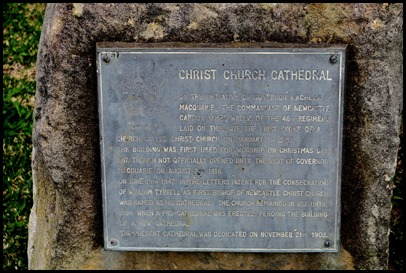 The
Plaque: Christ Church Cathedral. On the initiative of Governor
Lachlan Macquarie, The Commandant of Newcastle Captain James Wallis on the 46th
Regiment laid on this site the first stone of a church called Christ Church on
January 1st 1817.
The building was first used for
worship on Christmas Day 1817, though not officially opened until the visit of
Governor Macquarie on August 2nd 1818.
On June 19th 1847 in the letters
patent for the Consecration of WIlliam Tyrell as First Bishop of Newcastle,
Christ Church was named as his Cathedral. The church has remained in use until
1884 when a pro-cathedral was erected pending the building of a new
cathedral.
The present cathedral was
dedicated on November 21st 1902.
  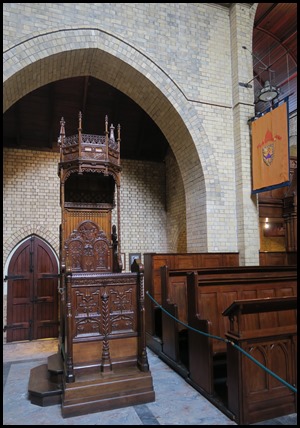 The ladies running the little shop
gave us a huge ‘welcome’, set us up with walking plans and history sheets. Our first look, the Baptismal
Font and the Throne.
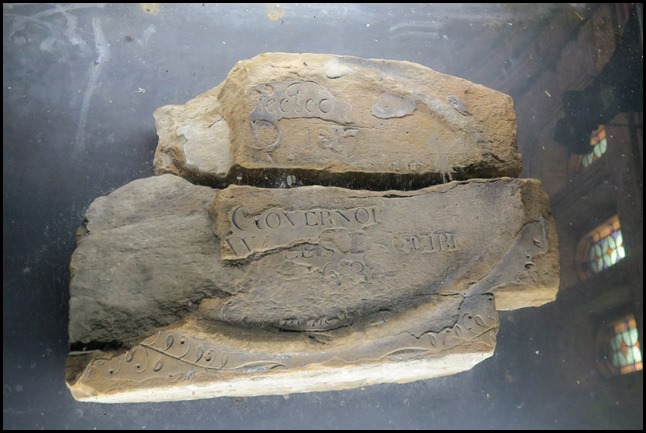 The foundation
stone of the first church on this site, laid by Commandant, Captain James
Wallis in 1817.
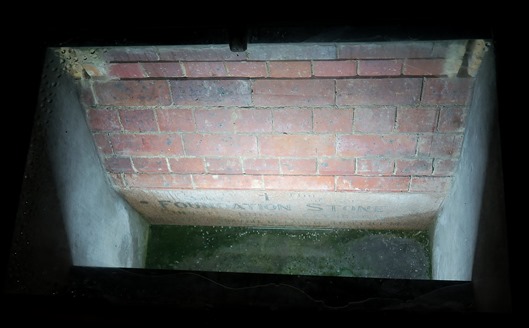 A Brief History: This is the Mother Church of the Anglican Diocese of Newcastle. A
Cathedral is the Church Building which contains the “throne” or official “seat”
of the Bishop of the Diocese.
It is believed that Christian worship
was first celebrated on this site as early as 1812, first in a small slab hut
with chimney at one end and bell cote at the other. This building was demolished
in 1816 to make way for a more permanent building. In 1817, the foundation stone
was laid for a church that was to serve as the Cathedral for nearly seventy
years. This foundation stone can now be seen in the
floor of the Cathedral at the end of the Nave. It is believed that this is near
the place it occupied in the original church.
By 1881 the first Cathedral was in
poor repair – “a crumbling building” is one description and a Cathedral Building
Committee set up and an appeal launched to build a worthy Cathedral to Mr.
Horbury Hunt’s design. The foundation stone was laid in
1892. It was to be forty-three years before the Nave of the Cathedral was
to be complete, with the exception of tower and transepts. Problems of
maintenance plagued the Cathedral and a crisis was reached in 1974 when much of
the roof was lost in a severe storm. The decision was made to complete the
building at a cost of some $700,000. By May 1979 the finished building was
dedicated and on the 25th of November, 1983, the Cathedral of Christ the King
was Consecrated.
On Thursday the 28th of December
1989, Newcastle was struck by a serious earthquake. The Cathedral was badly
damaged. Restoration work began in 1995 and was completed in 1997. The Cathedral
building was Re-Hallowed on the 31st of January 1997.
The Anglican Church of Australia is
part of the world-wide Anglican Communion, tracing their origins to the Church
of England. Anglicans are found in the United States of America where the Church
is known as the Episcopal Church, in Canada, Burma, throughout Africa, Latin
America, in Japan (Nippon Sei Ko Kei), New Zealand, South America, and
throughout Europe and the Middle East.
 The Story of the
Cathedral Kneelers: The first embroidered kneelers scheme was started in
England in 1930 by Louisa Pesel who founded the Winchester Broderers, She
revolutionised designs and materials which had previously simply been plain
fabrics, baize, leather or plush. The Kneelers programme for Christ Church
Cathedral began in 1987 when the wife of the then Bishop of the Diocese of
Newcastle, Mrs Joy Holland organised for each parish to complete one kneeler.
The first kneelers were made for the St Christopher Chapel, being a simple cross
with a choice of background colours. Basic green was chosen for the sides. This
was to compliment the carpet which was planned for the Nave Altar and the body
of the Cathedral. The Newcastle earthquake intervened and the floor of the Nave
and the St Nicholas and St Christopher Chapels was paved with Italian marble as
part of the restoration.
After some twelve years of constant
use many of the kneelers were in need of repair as they had originally been made
of thin foam rubber. It was decided to keep the original green sides and to
enlist the help of the entire Diocese in the remaking project. Offers of help
came from all over the Diocese, the Central Coast, the Hunter Valley, individual
church groups and from the Embroiderers Guild of Newcastle.
Many of the kneelers are unique
designs featuring symbols of the saints, Christian motifs, images of the Church
and the individual crests of the Deaneries, Parish organisations and the church
schools.
Mrs Brenda Dryden, who has worked on
many beautiful kneelers for the Nave felt she would like to make kneelers for
the St Michael Chapel (Warrior’s Chapel). The Dean of the Cathedral felt that
most appropriate would be kneelers for the Communion Rails.
 Mr and Mrs Dryden approached
Newcastle RSL Sub Branch who were happy to support the project with a donation
to cover all materials and now the results of three long kneelers featuring
designs representing the Army, Navy and Air Force can be seen in the Warrior’s Chapel. The remaking project is ongoing
today. The Cathedral provides the canvas, wool, foam etc. and all that is
required is the hard work in stitching the design. When finished the canvas is
returned to the Cathedral and after stretching, lacing and backing, is ready for
use. The beautiful tapestry kneelers now seen throughout the Cathedral and used
at every service are the result of the support of many and the talent and hard
work of a group of very committed people under the co-ordination of Mrs
Elizabeth Hicks. The thanks of the Cathedral community go to them – and very
proud they should be, we thought the kneelers were very lovely. We continued on
to the Warrior’s Chapel.
 The Description of
the War Memorial Mural, seen above with the Services themed
kneelers.
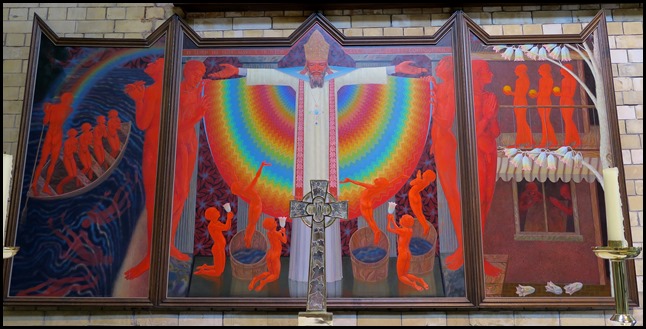 The Altar
triptych.
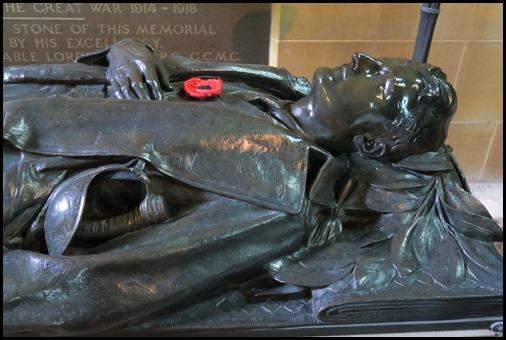 A Memorial by Cecil Thomas to the
fallen of the First World War. This effigy is of Alfred
Henry Forster of the Scots Greys, who died of wounds on the 10th of March
1919. “The original of this effigy is in the Church of All Hallows,
By-the-Tower, London”.
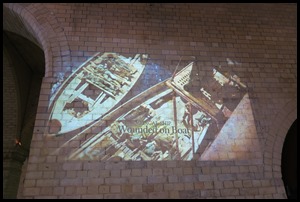 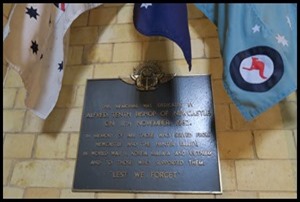 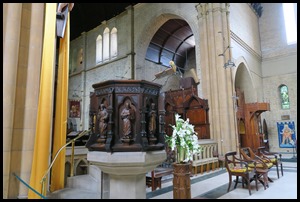 On the wall behind the Warrior’s
Chapel images were screened in memorial to local
accidents, losses and war dead. The joint Services
plaque and to our right the
pulpit.
   We walked around the back of the main altar, through the Tyrell
Chapel and found a splendid wooden chair dedicated to the memory of Captain Clarence Smith Jefferies VC, 34th Battalion, Australian Infantry, A.I.F. who died
aged twenty three on Friday the 12th of October 1917. Captain Jefferies was the
son of Joshua and Barbara Jefferies, of Abermain NSW. Native of Wallsend NSW.
Remembered with honour Tyne Cot Cemetery, Zonnebeke, West-Vlaanderen, Belgium.
On the wall was a cabinet containing precious
items; on the left was a set of replica medals
awarded to Captain Jefferies VC and below, those presented to The Reverend
Canon Bicton Clarence Wilson, Military Cross. On the right The Book of Gold, one of the most treasured possessions of
this Cathedral and was made by the finest craftsman available. The covers are
formed of plates of gold with the Dove of Peace in enamel work surrounded by
precious stones. It is the work of Mr. W. Mark of
Melbourne.
Inside, the
pages are richly illuminated and inscribe the names of the fallen from the
Diocese of Newcastle in the First World War. This was the work of Mrs. E. Dann
of Newcastle. The illuminations were inspired by the Book of Kells and the
inscriptions were done wholly by brush.
  St Christopher’s
Chapel and to the right a workbench.
 The note
about the workbench.
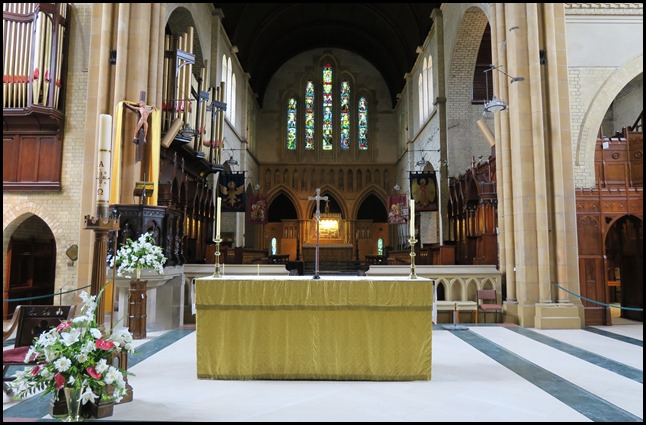 Looking through to the main Altar.
  The Last
Supper, beautifully backlit.
 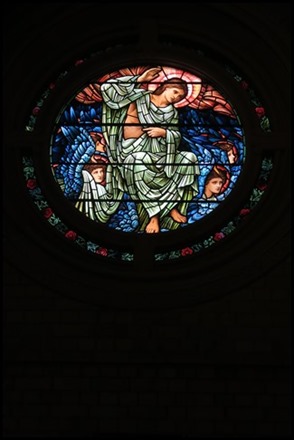  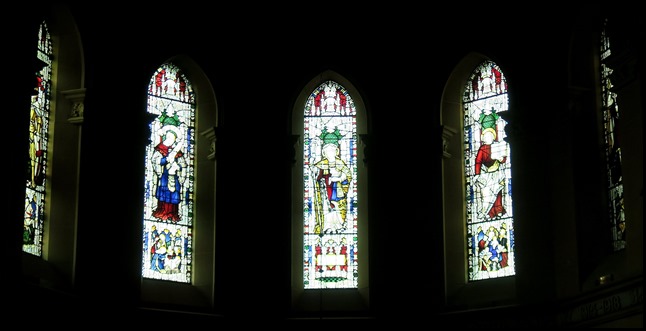 Some of the stained
glass.
The Cathedral is very large by
Australian standards. It is 72.5 metres long, 26.5 metres wide, 36.5 metres high
and contains 160 windows, 72 of which are filled with stained glass. In relation
to the City, the tower stands 77.5 metres above sea level and 38.5 metres above
the ground. From this elevation, the Church dominates the City which it serves
and is clearly seen by day and when floodlit by
night, from much of the City.
 ALL IN ALL SERENE FOR SUCH A
MODERN BUILDING
A REMARKABLE RED BRICK
CATHEDRAL
|